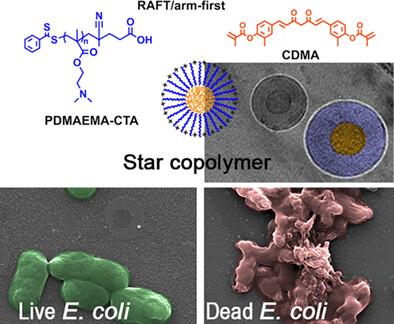Madson RE Santos, Clara LB Fidelis, Flávia S Zandonadi, Fernando C Giacomelli, Maria Isabel Felisberti
求助PDF
{"title":"姜黄素核两亲性星形共聚物用于细菌灭活","authors":"Madson RE Santos, Clara LB Fidelis, Flávia S Zandonadi, Fernando C Giacomelli, Maria Isabel Felisberti","doi":"10.1002/pi.6565","DOIUrl":null,"url":null,"abstract":"<p>Polymeric materials with antimicrobial properties hold the potential to be the next generation of therapeutics. This work reports the preparation of amphiphilic and star-like copolymers through arm-first and reversible addition–fragmentation chain transfer polymerization. The copolymers composed of poly(dimethylamine ethyl methacrylate) (PDMAEMA) as the arms and poly(curcumin dimethacrylate) (PCDMA) as the crosslinked core presented a well-controlled amphiphilic structure with low dispersity values (<i>Ð</i> = 1.15). Varying the [CDMA]:[PDMAEMA] molar ratios (4, 6 and 8) led to a significant increase in the molar mass (153, 688 and 1550 kDa), particle size (33, 90 and 105 nm) and the average number of PDMAEMA arms anchored to the curcumin-based core (12, 52 and 125 arms), as determined by dynamic and static light scattering. The antimicrobial activity of cationic PDMAEMA<sub>40</sub>-<i>co</i>-PCDMA<sub>core</sub> was tested against <i>Escherichia coli</i> in the absence of light and under white light to investigate the photodynamic activity of the copolymers. The results demonstrated a concentration dependence but no additional effect under light irradiation. SEM imaging and live/dead assays revealed extensive membrane damage, evidencing a membrane-disruption mechanism. HeLa viability assays demonstrated that at 1 mg mL<sup>−1</sup>, 80 ± 10% of the cells demonstrated metabolic activity after 24 h. © 2023 Society of Industrial Chemistry.</p>","PeriodicalId":20404,"journal":{"name":"Polymer International","volume":"73 1","pages":"21-29"},"PeriodicalIF":2.9000,"publicationDate":"2023-07-25","publicationTypes":"Journal Article","fieldsOfStudy":null,"isOpenAccess":false,"openAccessPdf":"","citationCount":"0","resultStr":"{\"title\":\"Amphiphilic star copolymers composed of curcumin core for bacterial inactivation\",\"authors\":\"Madson RE Santos, Clara LB Fidelis, Flávia S Zandonadi, Fernando C Giacomelli, Maria Isabel Felisberti\",\"doi\":\"10.1002/pi.6565\",\"DOIUrl\":null,\"url\":null,\"abstract\":\"<p>Polymeric materials with antimicrobial properties hold the potential to be the next generation of therapeutics. This work reports the preparation of amphiphilic and star-like copolymers through arm-first and reversible addition–fragmentation chain transfer polymerization. The copolymers composed of poly(dimethylamine ethyl methacrylate) (PDMAEMA) as the arms and poly(curcumin dimethacrylate) (PCDMA) as the crosslinked core presented a well-controlled amphiphilic structure with low dispersity values (<i>Ð</i> = 1.15). Varying the [CDMA]:[PDMAEMA] molar ratios (4, 6 and 8) led to a significant increase in the molar mass (153, 688 and 1550 kDa), particle size (33, 90 and 105 nm) and the average number of PDMAEMA arms anchored to the curcumin-based core (12, 52 and 125 arms), as determined by dynamic and static light scattering. The antimicrobial activity of cationic PDMAEMA<sub>40</sub>-<i>co</i>-PCDMA<sub>core</sub> was tested against <i>Escherichia coli</i> in the absence of light and under white light to investigate the photodynamic activity of the copolymers. The results demonstrated a concentration dependence but no additional effect under light irradiation. SEM imaging and live/dead assays revealed extensive membrane damage, evidencing a membrane-disruption mechanism. HeLa viability assays demonstrated that at 1 mg mL<sup>−1</sup>, 80 ± 10% of the cells demonstrated metabolic activity after 24 h. © 2023 Society of Industrial Chemistry.</p>\",\"PeriodicalId\":20404,\"journal\":{\"name\":\"Polymer International\",\"volume\":\"73 1\",\"pages\":\"21-29\"},\"PeriodicalIF\":2.9000,\"publicationDate\":\"2023-07-25\",\"publicationTypes\":\"Journal Article\",\"fieldsOfStudy\":null,\"isOpenAccess\":false,\"openAccessPdf\":\"\",\"citationCount\":\"0\",\"resultStr\":null,\"platform\":\"Semanticscholar\",\"paperid\":null,\"PeriodicalName\":\"Polymer International\",\"FirstCategoryId\":\"92\",\"ListUrlMain\":\"https://onlinelibrary.wiley.com/doi/10.1002/pi.6565\",\"RegionNum\":4,\"RegionCategory\":\"化学\",\"ArticlePicture\":[],\"TitleCN\":null,\"AbstractTextCN\":null,\"PMCID\":null,\"EPubDate\":\"\",\"PubModel\":\"\",\"JCR\":\"Q2\",\"JCRName\":\"POLYMER SCIENCE\",\"Score\":null,\"Total\":0}","platform":"Semanticscholar","paperid":null,"PeriodicalName":"Polymer International","FirstCategoryId":"92","ListUrlMain":"https://onlinelibrary.wiley.com/doi/10.1002/pi.6565","RegionNum":4,"RegionCategory":"化学","ArticlePicture":[],"TitleCN":null,"AbstractTextCN":null,"PMCID":null,"EPubDate":"","PubModel":"","JCR":"Q2","JCRName":"POLYMER SCIENCE","Score":null,"Total":0}
引用次数: 0
引用
批量引用


 求助内容:
求助内容: 应助结果提醒方式:
应助结果提醒方式:


